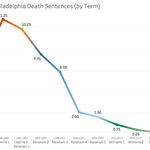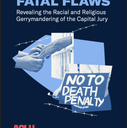
During his election campaign, Philadelphia District Attorney Larry Krasner described the economic wastefulness of city prosecutors’ pursuit of the death penalty as “lighting money on fire.” A DPIC analysis of the outcomes of the more than 200 death sentences imposed in the city since 1978 (click here to enlarge image) and the last seven years of capital prosecution outcomes provides strong support for Krasner’s claim.
Data tracking the final dispositions of cases in which Pennsylvania prosecutors had provided notice of intent to seek the death penalty showed that between 2011 and 2017, 98.7% of the 225 cases in which Philadelphia prosecutors had sought the death penalty ended with a non-capital outcome. Similarly, 99.5% of the 201 death sentences imposed in the city — mostly in the 1980s and 1990s — have not resulted in an execution. Two thirds of the convictions or death sentences have already been reversed in the courts and 115 of the former death-row prisoners have since been resentenced either to life sentences (101) or a term of years (11) or been exonerated (3). The single execution was of a severely mentally ill man whom courts initially found incompetent to waive his rights, but was later permitted to be executed.
DPIC Executive Director Robert Dunham announced the results of the DPIC analysis at the National Constitution Center in Philadelphia at a news conference conducted by the death-row exonerees’ organization Witness to Innocence. Dunham said that the data showed Philadelphia’s pursuit of the death penalty has been “a colossally inefficient” waste of judicial resources and “a colossal waste of money.”

Death sentences imposed in Philadelphia peaked in the first term of District Attorney Ronald Castille’s administration in 1986 – 1989, when an average of 11.25 death sentences per year were imposed. 99 more death sentences were imposed in the decade of the 1990s. By 2001, 135 prisoners were on Philadelphia’s death row, and the 113 African Americans on its death row were more than in any other county in the United States. Since then, death sentencing rates have plummetted, falling to 1.5 per year in 2006 – 2009, the final term of District Attorney Lynn Abraham’s administration, and to fewer than one a year this decade, during the administration of Seth Williams. But even as the number of death sentences fell, the proportion of defendants of color sentenced to death in Philadelphia increased. In the past two decades, 82.6% of the defendants sentenced to death in Philadelphia have been African American. Of the 46 defendants sentenced to death in Philadelphia since 1997, 44 (95.7%) have been defendants of color.
Krasner’s campaign pledge not to use the death penalty, Dunham said, was a “natural conclusion” of the steep decline in death penalty usage in the city.
To see the DPIC Philadelphia infographics from the Witness to Innocence news conference, click here.
Posted, Death Penalty Information Center: November 16, 2018.



